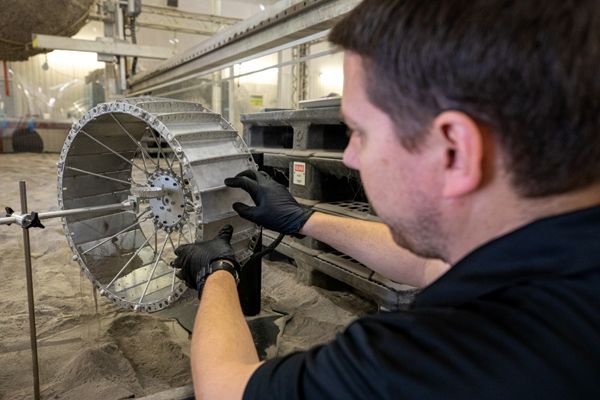
NASA
When the Moon Dust Settles, It Won’t Settle in VIPER’s Wheels (News Release)
Moon dust is a formidable adversary – the grains are as fine as powder and as sharp as tiny shards of glass. During the Apollo 17 mission to the Moon, the astronauts lamented how the dust found its way into everything, coating their spacesuits and jamming the shoulder joints, getting inside their lunar habitat and even causing symptoms of a temporary "lunar dust hay fever” in astronaut Harrison Schmitt. Those symptoms fortunately went away quickly – but the problem of Moon dust remains for future missions.
NASA’s new Moon rover, the Volatiles Investigating Polar Exploration Rover, has been running tests to ensure its wheel module components are dust-proof in advance of going to the Moon in 2023. VIPER’s job is to hunt for water resources at the Moon’s South Pole, creating the first resource maps for human space exploration before astronauts arrive under NASA’s Artemis program in 2024.
But that dust, though.
The grating grains in question were formed by millions of years of meteorite impacts that repeatedly crushed and melted rocks, creating tiny shards of glass and mineral fragments. Because the Moon has no atmosphere to speak of, there’s no wind or weather to cause erosion, so the grains never lose their rough edges. When lunar dust gets inside moving parts, like those in a rover’s wheel, it’s so abrasive that it can damage the mechanisms. And the more joints you have in a system, the more places you have for dust to creep in. VIPER’s required agility means it has a lot of joints.
No one is quite sure what to expect from the soil in the polar regions the rover will explore. Will it be compacted? Or fluffy, like ash? To work around that uncertainty, VIPER needs to be agile. Each of the rover’s four wheel modules were designed with both an active suspension and independent steering. This means VIPER can drive sideways or diagonally and even spin in a circle. The rover can move in any direction without changing which way it’s facing, so its science objectives and solar panel charging can be optimized. And, if it encounters really soft soils, it will be able to twist and turn and pull itself out, like a turtle on the beach.
To ensure the dirt stays out during this dance, the VIPER team recently tested one part of their mitigation method in a dust chamber at NASA’s Johnson Space Center in Houston. The dust chamber is an open-topped box, 20 by 20 by 34 inches, with clear acrylic walls. Inside, there is simulated lunar soil and a robot mounted on one wall. Its job is to move a VIPER wheel module – including driving, steering and suspension components – through its full range of motion. The whole wheel unit is shrouded in a flexible, protective cover that will both insulate it from the cold on the Moon and seal it against dust. Only the axle protrudes from this “sock”, where the wheel will attach.
During the test, two fans circulated lunar dust within the box to create a really challenging, dusty environment. The fans were repositioned every hour to ensure VIPER’s wheel was exposed to dust from every angle. This method allowed the team to perform a stringent test, throwing even more at their design than the rover could likely ever stir up during the mission.
When the test was over and the dust had settled, it was all outside VIPER’s wheel. None of it had snuck in through the sock, confirming that its seams and the connections sealing the sock to the wheel hardware had worked.
And that’s only the first line of defense against dust. Researchers at NASA’s Kennedy Space Center in Florida are also testing the various seals for the electric motors that drive VIPER’s wheels. Each motor is protected by three types: a winding labyrinth seal, a flexible felt seal and a spring-loaded Teflon seal. The rover will be equipped with heaters to keep the extremities of the system warmer than minus 112 degrees Fahrenheit, even when the lunar environment gets much colder. The tests at Kennedy will verify the seals’ performance after they reach this low and warm back up to their normal operating temperature of about minus 40 degrees Fahrenheit. For this, a prototype of VIPER’s wheel motor will be operated inside another test chamber, one that simulates multiple conditions the rover will experience on the Moon, including exposure to the vacuum of space, extreme temperatures and, of course, all that dust.
Source: NASA.Gov

No comments:
Post a Comment